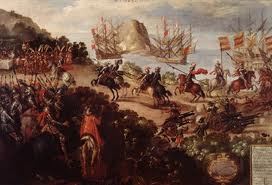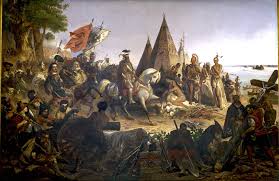History of Horseback Riding in Spain; From Alta Mira to the American Plains
The arrival date for the first wild horses to reach Spain after their ancestors crossed the Bering Straits from America is lost to us in the mists of history. We do know horses had arrived there about 30,000 years ago because of the fabulous cave drawings of them discovered in Alta Mira and other caves which are about that old. When they were first used for horseback riding is another question because at the time of the paintings they were probably just used for eating and may only have been hunted rather than domesticated. It is probably a good guess to say that mankind started riding horses in Spain about six thousand years ago. The Celts, Carthaginians and Romans all influenced equestrian activities there, but the greatest influence on the blood lines of modern Spanish horses was the Moorish conquest of Andalusia and most of the Iberian Peninsula in 711 AD
The Moorish cavalry, mounted on swift Barb and Arab horses, quickly spread across southern Europe deep into France where they were finally defeated by Charles Martel at the battle of Poitiers in 732 and gradually forced back south of the Pyrenees. The lighter Barb and Arab lines were mixed with the heavier Iberian stock to breed the Pure Spanish or Andalusian horse. Almost 800 years of intermittent warfare followed until 1492 when the Spaniards finally captured the last Moorish stronghold of Granada. Of course cavalry played a dominant part in these battles of the “Reconquista”.
By the end of the 15th century the Andalusian breed was well established and sought after by the aristocracy. These powerful, athletic and elegant animals were a potent war machine and made excellent mounts for sports like dressage and bull fighting. The Hapsburg Emperor in Vienna also ruled Spain at that time and used these horses to help create the famous Lippizaners, renowned for their performance in dressage and effectiveness in warfare.
 The same year that Granada surrendered Spain turned its attention to the new world and rapidly carved out a huge empire from Mexico to Tierra de Fuego, a task which would have been nearly impossible without the help of the magnificent horses they brought with them. The mighty civilizations of the Aztecs and the Incas crumpled before the Spanish cavalry which gave them a huge psychological as well as a military advantage. The natives had no experience in withstanding a cavalry charge so that the Conquistadores were able to defeat vastly superior numbers. Huge quantities of gold and silver flowed back to Spain from the plundered treasures of these new colonies, making Spain the richest country in Europe and transforming its economy.
The same year that Granada surrendered Spain turned its attention to the new world and rapidly carved out a huge empire from Mexico to Tierra de Fuego, a task which would have been nearly impossible without the help of the magnificent horses they brought with them. The mighty civilizations of the Aztecs and the Incas crumpled before the Spanish cavalry which gave them a huge psychological as well as a military advantage. The natives had no experience in withstanding a cavalry charge so that the Conquistadores were able to defeat vastly superior numbers. Huge quantities of gold and silver flowed back to Spain from the plundered treasures of these new colonies, making Spain the richest country in Europe and transforming its economy. 
For nearly 200 years the Spaniards were able to keep an effective monopoly on horses and prevented them from falling into native hands in any number, but in 1680 the Pueblo Uprising changed all that. About a thousand horses escaped or fell into Indian hands and the wild ones thrived and multiplied; some say the wild herds from this superb stock numbered over 3 million by the end of the 18th century. It transformed the lives of the Plains Indians whose culture flourished for a century and a half.
The introduction of Spanish horses to the Americas also had an enormous influence on the culture and development of Latin America. The colonies in the Americas were also profoundly impacted by the Spanish conquest. Whether riding the Peruvian Paso in Peru or enjoying colonial era haciendas in Ecuador the influence of Spain is ubiquitous in the South America of today.
Wars when the French invaded and took many of the best horses for its own army. During the 19th century intermittent wars and chronic political instability resulted in the loss of Spain’s possessions in the Americas. After that came the dark time of the Spanish Civil War and the country never fully recovered until after the end of World War II, but since that time Spanish horses have made a spectacular comeback.There are wonderful opportunities for horseback riding in Spain today.
Article written by Bayard Fox

